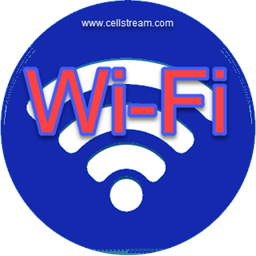Retransmissions of frames in WLANs (Wireless Local Area Networks) can become problematic for several reasons, primarily due to the nature of the wireless medium. While retransmissions are a necessary part of ensuring data integrity in unreliable networks, they can cause inefficiencies and degrade network performance. I will get to the details below, but let’s start with defining what retransmissions are.
What are Retransmissions in a WLAN?
In a Wi-Fi WLAN, multiple devices can share the same frequency spectrum (the wireless medium). When two or more devices try to transmit data at the same time, their signals can collide, essentially interfering with each other, causing data loss and forcing retransmissions. While the RTS/CTS process helps to reduce these collisions by providing a clear way for devices to request permission to transmit collisions can still occur.
Let’s illustrate how retransmissions occur, and observe the frame transmissions:
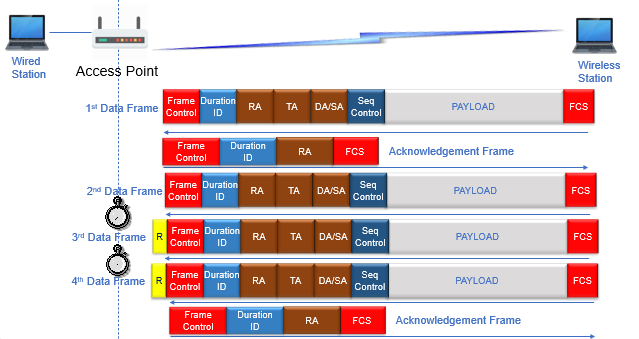
In the illustration, we see the 1st data frame transmitted to the AP, and the AP acknowledges the frame. This is a good transmission.
However, we see the 2nd data frame is sent, but after a reasonable time, there is no acknowledgement. This must mean that the frame was not received and it must be retransmitted. Notice the yellow retransmit is added to the retransmitted frames. This is great! If we can listen to the traffic in a WLAN and note how many frames are retransmitted, we can get an idea as to how the performance may be degraded in this WLAN.
In the illustration, we see this actually takes multiple attempts, and it isn’t until the 4th frame that we then see an acknowledgement.
What are the impacts of retransmissions in a WLAN?
Here’s why retransmissions can be an issue in WLANs:
1. Increased Network Congestion
When a wireless frame is lost or corrupted, it needs to be retransmitted. This additional transmission increases the overall traffic load on the network. Since WLANs typically use a shared medium (e.g., radio frequencies), every device competes for access to the same wireless channel. More retransmissions mean more congestion and less available bandwidth for other devices on the network. This can lead to delays and performance degradation for all users.
2. Reduced Throughput
Retransmissions take up valuable airtime that could have been used to send new data. Every time a frame needs to be retransmitted, it decreases the effective throughput of the network because it uses the same resources as the original transmission but without delivering additional information. As the number of retransmissions increases, the actual data throughput (the rate at which useful information is successfully delivered) decreases. This is particularly noticeable in environments with a lot of interference or where devices are far from the access point.
3. Increased Latency
In WLANs, retransmissions introduce delays because the system must wait for a timeout before attempting a retransmission. If a frame needs to be retransmitted multiple times, these delays add up, significantly increasing the overall latency for the affected communication. Increased latency can negatively impact time-sensitive applications like voice over IP (VoIP), video conferencing, and online gaming, which require low-latency communication to function properly.
4. Collisions and Backoff Times
WLANs use a medium access control method called CSMA/CA (Carrier Sense Multiple Access with Collision Avoidance), where devices must listen to the channel before transmitting to avoid collisions. If multiple devices try to transmit simultaneously, collisions can occur, especially in dense environments. When collisions happen, frames are lost and need to be retransmitted. After a collision, devices use a backoff mechanism (random delay) before attempting to retransmit, leading to even more idle time and further reducing the network’s overall efficiency.
5. Energy Consumption (Battery Drain)
Retransmissions lead to more frequent transmissions and receptions, which consume more power on wireless devices such as smartphones, laptops, and IoT devices. Devices, especially battery-operated ones, will drain their batteries faster because they need to spend more time retransmitting frames or waiting for data to be retransmitted. This can be a major issue for mobile devices and sensor networks where energy efficiency is critical.
6. Interference from Environmental Factors
WLANs operate in the 2.4 GHz and 5 GHz (and now 6 GHz) frequency bands, which are often shared with other devices (such as Bluetooth, microwaves, and cordless phones). These environmental factors introduce interference that can lead to frame corruption, triggering retransmissions. The more interference there is, the more likely frames are to be corrupted, and the more retransmissions will be required. This exacerbates network congestion and reduces the quality of the wireless experience.
7. Hidden Node Problem
In WLANs, devices may be out of range of each other but still within range of the same access point. This is known as the hidden node problem, where two devices can’t “see” each other’s transmissions, resulting in undetected collisions at the access point. Undetected collisions lead to frame loss, and consequently, retransmissions. This results in more traffic on the network and can significantly reduce throughput and increase delays.
8. Interference from Other Networks (Co-channel Interference)
In densely populated areas (like apartment buildings or offices), multiple WLANs may operate on the same or overlapping channels. This co-channel interference can lead to higher frame error rates as signals interfere with each other. More frame errors mean more retransmissions, increasing contention for the wireless medium and further reducing the efficiency and performance of the network.
9. Retransmission Limits and Packet Loss
In most WLAN protocols (like 802.11), there is a limit to how many times a frame will be retransmitted. After this limit is reached, the frame is dropped, resulting in packet loss. While packet loss is common in wireless networks, too much of it can severely degrade the performance of higher-level applications, especially real-time services like VoIP or video streaming, which may not have time to recover from lost packets.
10. Interference with Other Services
Since WLANs share the radio frequency spectrum with other devices, frequent retransmissions due to interference can spill over and affect other services, causing poor performance for those devices as well. Devices like Bluetooth headphones, ZigBee sensors, or other WLANs may experience reduced performance or increased interference because of the additional traffic caused by retransmissions.
11. Decreased Quality of Experience (QoE)
The overall user experience in a WLAN can suffer due to retransmissions. Applications that require high bandwidth and low latency, such as video streaming, video conferencing, and online gaming, are particularly sensitive to retransmissions. The user may experience buffering, lag, or dropped connections. Even small increases in retransmissions can degrade the Quality of Experience (QoE), leading to frustration for users and, in some cases, dropped connections in critical scenarios.
Wow. Detecting these retransmissions is a critical skill for Technicians to have, and critical that this is looked at in WLANs they support.
So how is this done?
How to Detect Retransmissions in WLANs
The only way I know to do this is to either have a Wi-Fi scanner that detects retransmissions (not many of them do), and reports them (albeit there may be limitations), or to do packet capture and then examine the packet capture.
Retransmissions using a Wi-Fi Scanner
The only scanner that comes to mind that does this is the Windows only WinFi Scanner (you can learn more about this great scanner here). That said, if you use a cloud solution for managed Wi-Fi, those solutions may provide this information. Check with your vendor. If someone knows this, please send me a comment here using the little envelope of on our Discord server – link at the bottom.
Retransmissions using Wireshark Packet Capture
Packet capture from a WLAN network in Wireshark is easy with MAC OS or Linux, but a major pain in Windows. Read more on this here.
For now these are the critical ingredients:
- You will need Wireshark (free from the Wireshark web site)
- You will need the ability to go into monitor mode (may need an external USB interface for Windows that can go into monitor mode: see our article here).
- You will also need our Wireless LAN Troubleshooting profile – you can find that here.
Assuming you have these, simply do a packet capture using the monitor mode and interface, and then in the profile, click on the display filter button “RETRIES”. If there are any frames being retransmitted they will show up.
First, download a 1-packet example of a retry:
Then open it in Wireshark. You should have this assuming you have the profile installed and selected:
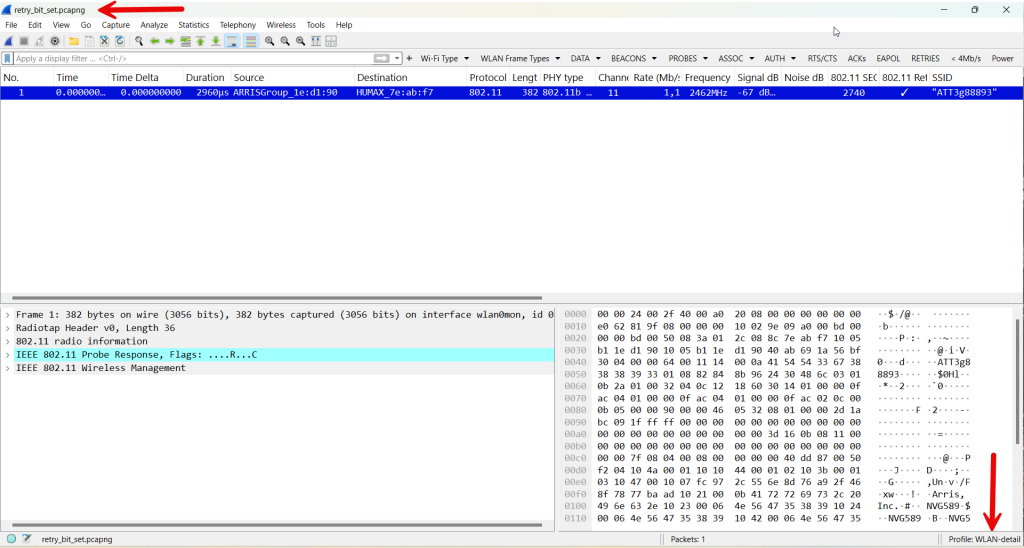
Now, expand Probe Response > Frame Control> Flags You should have the following (I resized my panes):
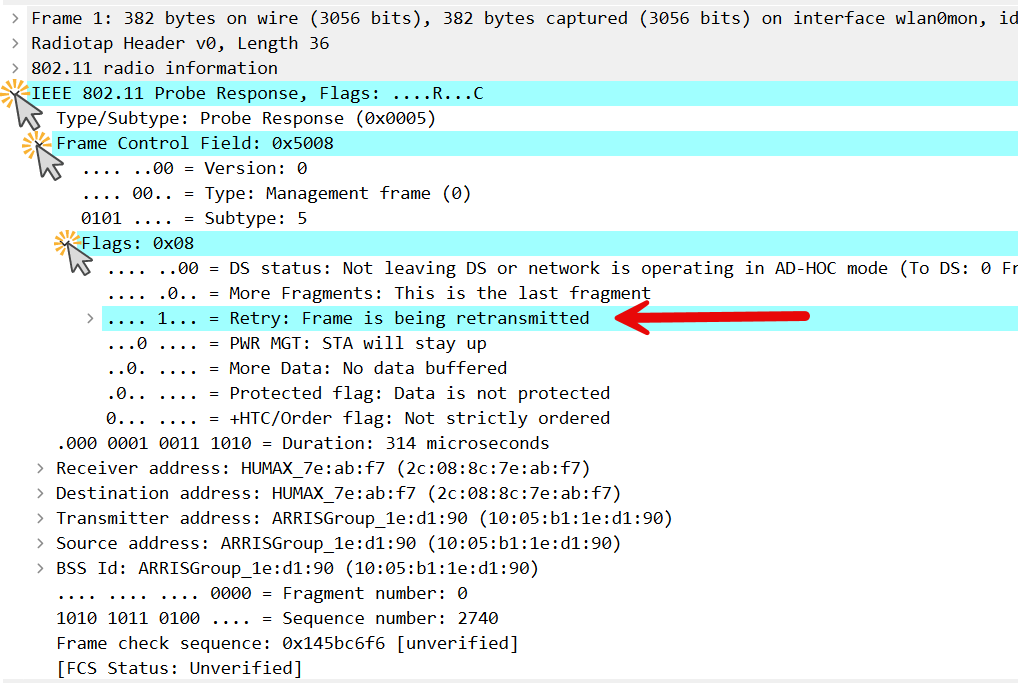
Any time this bit is set, it means there has been a retransmission of the packet.
Some of you will note this is a Probe Frame. Probes can often get this issue because you aren’t actually on the WLAN yet, so you are just walking into the party asking for networks you know without taking your turn!!
So we probably do not care about probes, but if data packets are being retransmitted, that is a sure sign the network is likely to be congested. It is also likely that many other frames are being retransmitted as well.
Below is an great example of a complaint that the Roku box was not working. When a packet capture was done (1), and the filter for the retries was applied (2), we see that 79% of the data traffic was retries (3) !!!! This is not a Roku problem, this is an overcrowded, noisy WLAN network. The fix was to move some things to be plugged into the Ethernet ports, and then move some things to the 2.4GHz channel instead of this channel 149 that was having all these issues. Sure enough, the Roku box worked great.
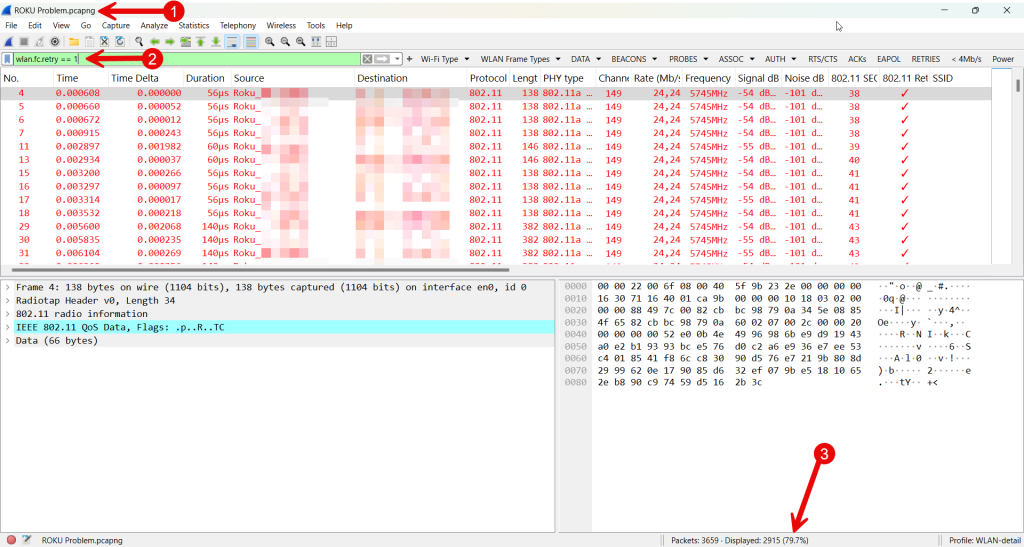
I hope this has enlightened the reader with this relatively simple but hardly looked at issue with WLAN’s.
Remember, Technicians (or really anyone), you need my Networking Toolkit for Windows as well: you can read about and grab that here.
Comments are welcomed below from registered users. You can also leave comments at our Discord server.
If you would like to see more content and articles like this, please support us by clicking the patron link where you will receive free bonus access to courses and more, or simply buying us a cup of coffee!

